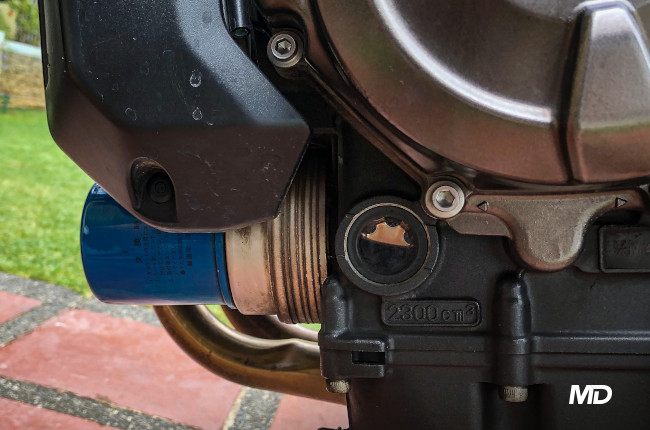How to check your motorcycle’s oil level
Oil is the lifeblood of your motorcycle, so it's absolutely essential that your oil is always topped up and in good condition.

Maintaining a motorcycle is arguably more tedious than maintaining a car. Things get even more complicated if your motorcycle of choice is a high-performance big bike. Motorcycles require more attention to detail, as well as more mechanical know-how in order to ensure that everything is running smoothly and reliably. For the most part, their service intervals are also significantly lower than that of cars, meaning oil changes and regular maintenance jobs must be performed more often.
Today, we’re going to take a look at one of the most vital elements when it comes to the health of your motorcycle’s engine. It’s all too easy to overlook inspecting your engine oil every now and then, as the temptation of swinging a leg over and simply going out for a ride can be all too strong. However, the fact of the matter is that motorcycle oil degrades much faster than you think, especially in a wet-clutch system, as is found on most bikes. That said, it could pay dividends to regularly check your engine oil to see if firstly, you have the optimum amount, and secondly, to see if it’s still in good condition.
Get your bike up to operating temps

Now, checking your engine oil is a relatively straightforward process. While this may vary from bike-to-bike, all motorcycles generally have a way to clearly and accurately check their oil level. Firstly, you’re going to want to have your bike’s engine up to operating temperatures. That said, you may want to take it for a short ride around your neighborhood, or check your engine oil level after your daily commute. Engine oil behaves differently when it’s up to temp, as it becomes more runny when hot, and more viscous when cold.
Let your bike sit for a few minutes

Once you’ve returned home, shut off the engine and let your motorcycle sit for around five minutes. When the engine is running, the oil pump feeds engine oil into the galleries and all the nooks and crannies of the engine in order to provide proper lubrication. That means, if you check your engine oil the instant you switch the bike off, chances are you’re going to have a false low reading. Letting the bike sit allows all the oil to settle, thus providing a more accurate oil reading.
Check your oil level

Once you’ve waited a couple of minutes, you’re going to want to stand your motorcycle upright. Now this can either be a simple job, if your bike has a center stand built-in, or a rather daunting job, especially if your big bike doesn’t have a center stand and weighs close to 200 kg. That said, it helps to have a paddock stand, or if not, a buddy to hold your motorcycle upright while you inspect the oil level.
Now, the method of inspection varies from bike to bike. Some bikes come with a dipstick inside the oil filler cap. Just like in a car, pull out the dipstick, and ensure that the oil is within the minimum and maximum lines. While you're at it, inspect the condition of the oil. If it looks very dark, almost black in color, then it may be time to have your oil changed. Other bikes make it a lot easier to check their oil level, as they come equipped with a sight glass located at the bottom of the crankcase. Simply take a look at the sight glass with your bike upright, and make sure the oil level is within spec, and in good condition.
Related Articles
-
5 DIY maintenance jobs that can save you lots of money / Featured Article
Here are 5 do-it-yourself maintenance jobs that you can learn. Doing these maintenance items yourself not only help you learn more about your bike, but will help you save money in the proces...
-
5 things that could save your life during a motorcycle-related emergency / Featured Article
Find out how you can help prepare yourself for a variety of emergencies on the road.
-
These 3 signs tell you it's time for a new chain and sprocket / Featured Article
Never ignore these 3 warning signs that could mean that your bike needs a new chain and sprocket.
-
Follow these 3 tips to extend the service life of your motorbike’s battery / Featured Article
A motorcycle’s battery is considered as the heart of its electrical system, as such, taking good care of your battery can dramatically extend its lifespan.
-
Is your motorcycle out of warranty? Be sure to check these items ASAP / Featured Article
If your motorcycle is out of warranty, it’s now your duty to make sure you stay on top of its maintenance no matter what, or run the risk of facing a hefty repair bill.
Latest Features
-
Last-minute Christmas gift ideas for your rider friends and family / Featured Article
Struggling to think of gift ideas for your motorcyclist friends and family? Read on to get some inspiration this gift-giving season.
-
Ride a naked sportbike? Get these 5 upgrades first / Featured Article
Here’s a quick list of 5 upgrades to your naked sportbike to enhance your riding experience.
-
Motorcycle 101: The inner workings of a slipper clutch / Featured Article
Slipper clutches are awesome as they make for more forgiving downshifts and a lighter clutch lever. Let’s take a closer look at them and see how they work.









